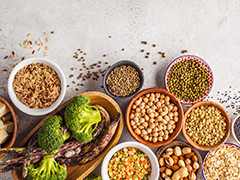Here’s Why You Need More Fiber

Surely you’ve heard this message over and over: eat more fiber. There's a good reason for it. Eating foods with dietary fiber is crucial in supporting a healthy digestive system—but the benefits don’t end there.
Consuming the right amount of fiber helps you maintain a healthy weight and it can help prevent diabetes, heart disease and some types of cancer. Plus, foods high in fiber keep you feeling full for longer, which can aid in weight loss.
There are actually two different types of fiber: soluble and insoluble. Both play major roles in supporting your overall health. To maximize the benefits of both, you need to consume a variety of foods.
Soluble fiber dissolves in water into a gel-like substance. It helps lower cholesterol and glucose levels.
- Foods rich in soluble fiber include avocados, oats, peas, broccoli, sweet potatoes, beans, apples, citrus fruits, and carrots.
Insoluble fiber stays mostly intact in water so it keeps a regular movement of material through your digestive system.
- For foods loaded with insoluble fiber, look for dark, leafy greens, wheat bran, nuts, cauliflower, green beans, potatoes and skin-on fruits, like blackberries or apples.
Here’s how much fiber you should aim to eat:
- Adult males:
- 30 to 38 grams per day
- Adult females:
- 21 to 25 grams per day
Tricks to incorporate more fiber into your diet:
- Switch to cereals with 5 grams or more of fiber per serving or switch from cereal to oatmeal, which has 4 grams of fiber per cup.
- Substitute regular pasta for whole wheat pasta.
- Just one serving yields 6 grams of fiber. Also try replacing white rice with brown rice, which has 3.5 grams of fiber per cup vs. just .6 grams in white rice.
- Incorporate beans, peas and nuts into meals and snacks.
- Pack your snacks with high-fiber treats, like whole grain crackers, nuts and fresh (or dried) fruits. Just be careful of nuts and dried fruits because they are usually higher in calories.
It’s easy to see why fiber is the foundation of a healthy digestive system. The good news? If you already eat plenty of fruits and vegetables, chances are you’re getting a good amount of fiber. If not, all it takes is a couple of tweaks here and there.
Click here to schedule a telehealth appointment with a nutritionist. Together, you can build a plan to get the right amount of fiber.
Source:
https://www.mayoclinic.org/healthy-lifestyle/nutrition-and-healthy-eating/in-depth/fiber/art-20043983


